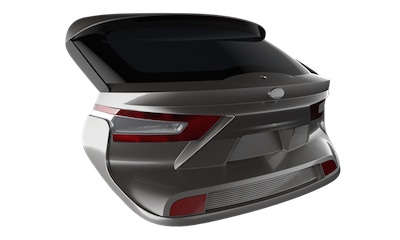Plastics Industry Association report: Next-gen transport will open up increased opportunities for plastics
Plastics Industry Association report cites numerous instances where electric vehicles and autonomous cars will exploit the properties of plastics; aviation and mass transit also present opportunities.
February 13, 2019

Did you know that a 10% reduction in vehicle weight results in an estimated 5 to 7% reduction in fuel usage? And that of the approximately 30,000 parts in an automobile, one-third are plastic? How about the fact that in 2016, the average light vehicle contained about 330 pounds (150 kg) of polymer composites that accounted for over 50% of the total vehicle volume?
|
Liftgates are just one major component in automobiles where plastics uses is increasing. |
These fun facts, and more serious matters, feature in a recent report—Plastics in Motion with Today’s Trends in Transportation—published by the Plastics Industry Association (PLASTICS; Washington, DC). The report also highlights insights from industry innovators and thought leaders from companies including GM, Tesla and Audi.
“Due to current trends, we expect for plastics to become a solidified material in transportation vehicles and other technologies,” said PLASTICS’ Chief Economist, Perc Pineda. “Engineers and designers use plastic for vehicle materials because of its weatherability and moisture repellence, safety advances, improved comfort and other properties, many of which are in the research and development stages. Considering that demand for transportation is not going away anytime soon, plastics will remain a viable material in the transportation space,” Pineda added.
“Plastics’ role in the automotive and transportation sector has been growing for years, which was why PLASTICS created the Transportation and Industrial Plastics (TIP) committee in 2015,” said PLASTICS Interim President and CEO Patty Long. “TIP has grown in membership and in stature to include some of the most important voices in this increasingly important sector for the plastics industry. Its contributions were vital to creating this most-recent Plastics Market Watch report, which shows the sky continues to be the limit for plastics in transportation.”
The scale of transformation within the transportation sector with electric propulsion is unprecedented—and will influence all suppliers, including plastics. “The flexibility of plastics in terms of performance, design, weight and costs could be an advantage as electric vehicles increase market share,” said Kendra L. Martin, Vice President–Industry Affairs, PLASTICS. “Plastics currently available meet the specifications of electric motors; it will be interesting to see new polymers come forth as EV technology takes hold.”
EVs designed from the ground up will bring new opportunities for plastics according to industry experts. “What the electric vehicle allows is for car manufacturers to design their vehicles in a fundamentally different way. That opens up for considerable breakthroughs in terms of design,” Patrick Cazuc, Global Automotive Marketing Director, at DuPont told Chemical & Engineering News. An advantage plastics provide engineers is the ability to mold form-fitting parts with polyamide brackets—eliminating the need for additional assembly that steel or aluminum would require. Shaping with thermoplastic polyolefins and other polymers has already made cars quieter and more ergonomic; for EVs these materials can be used to design a wide-range of parts.
On other developments cited in the report, “By 2025, more than half the vehicles produced will have a rear liftgate or hatch in the back, whether it’s an electric power-train or traditional power-train. We are poised to offer a thermoplastic liftgate that is 25 to 40 percent lighter than traditional steel offerings,” said Brian Krull, Global Director of Innovation, Magna International.
With EVs, the front end of vehicle designs may also change, providing another opportunity for plastics and thermoplastics. EV cooling requirements are different than internal combustible engines, which may eliminate the need for certain kinds of grills and front fascia, and open the door to EV design differentiation.
Plastics will also be called on to potentially house and protect in-vehicle autonomous technologies; connectors and sensors are key plastics-intensive components. And these components must also be protected from heat. Without proper thermal measures, components such GPS, automatic door openers and rear-view camera could be exposed to oven-like temperature.
About the Author(s)
You May Also Like





